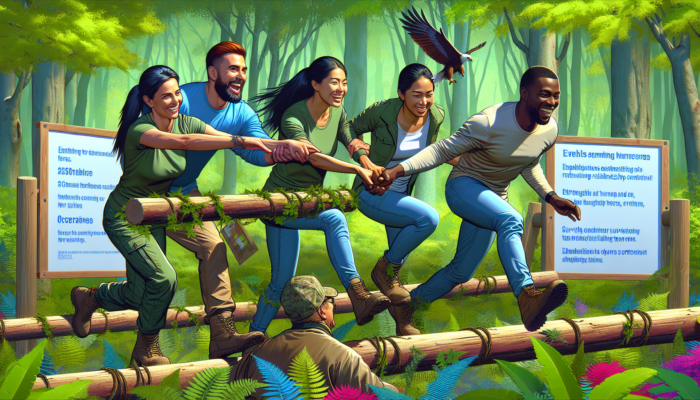Effective Strategies for Developing a Strong Survival Team: Boosting Team Dynamics Through Real-World Challenges
In-Depth Exploration of Survival Team Building: Key Principles and Goals

Survival team building presents a proactive approach that harnesses the power of challenging and high-stress environments to significantly enhance team dynamics and promote collaboration. This innovative strategy immerses participants in realistic survival scenarios that demand swift decision-making, creativity, and efficient teamwork. The primary goals of these dynamic activities include improving communication skills, fostering trust among team members, and cultivating essential problem-solving abilities—each of which is crucial for forming a cohesive and high-performing team.
The essence of survival team building is its capacity to challenge individuals to step outside their comfort zones. As participants confront obstacles that closely resemble real-life situations, they find themselves relying on one another, which nurtures a culture of mutual support and cooperation. These experiences extend beyond simply surviving; they focus on thriving collectively, learning strategies to address challenges as a cohesive unit, and emerging as a more robust, unified group.
Additionally, the lessons learned from these unique experiences reach far beyond the immediate activity. Participants often discover that the skills they hone during these challenges are applicable in their daily work environments, empowering them to tackle problems from a fresh perspective. This reinforces the concept that survival team building is not just a transient event but a transformative catalyst for ongoing team development and enhanced effectiveness.
Significant Advantages of Survival Team Building for Corporate Teams
Engaging in survival team-building activities offers a wealth of benefits for corporate teams. One of the most notable advantages is the marked enhancement in communication skills. In various survival scenarios, the capacity to convey ideas clearly and effectively becomes paramount. Team members must articulate their thoughts, actively listen to one another, and provide constructive feedback. This practice dismantles barriers and cultivates a culture where open dialogue thrives, ultimately fostering a more collaborative workplace atmosphere.
Trust stands out as another critical component of effective teamwork, and survival team-building activities are specifically designed to nurture this essential quality. When team members confront challenges together, they learn to depend on one another, forging connections that are often challenging to establish in a conventional office environment. This trust translates into stronger interpersonal relationships, thereby enhancing team cohesion and collaboration in everyday tasks.
Moreover, problem-solving skills become a central focus during these activities. Participants frequently encounter complex scenarios that require innovative thinking and prompt decision-making. By tackling these challenges collectively, teams cultivate a unified approach to problem-solving, which leads to more efficient solutions in their work environment. The competencies cultivated from survival team-building activities empower teams to confront issues with confidence and creativity, fostering a culture of innovation.
Key Components for a Successful Survival Team Building Program
Designing an effective survival team-building program necessitates careful consideration of several fundamental components. The challenges presented should be realistic and pertinent to the participants involved. Customizing these challenges to reflect the specific dynamics and objectives of the team ensures that the experience is both engaging and impactful.
Clearly defined objectives are equally crucial. Before embarking on a survival challenge, teams must comprehend the purpose behind the activity. Whether the goal is to enhance communication, cultivate trust, or improve problem-solving skills, having specific targets enables participants to focus on what they need to accomplish.
Professional facilitation is another vital aspect of a successful program. Experienced facilitators can guide teams through the challenges while ensuring a safe and productive environment. They offer invaluable insights, facilitate discussions, and assist participants in reflecting on their experiences, thereby enriching the overall learning process.
Furthermore, the enjoyment factor should never be underestimated. A well-structured program balances challenge and fun, ensuring that the experience is memorable while effectively achieving the desired outcomes. By incorporating these essential elements, organizations can create a survival team-building program that delivers meaningful results and fortifies team dynamics.
Understanding the Psychological Aspects of Survival Team Building

The Role of Stress in Shaping Team Building Dynamics
Moderate levels of stress can significantly enhance team performance during survival team building activities. When faced with challenging scenarios, teams experience an urgency that compels them to collaborate more effectively. This pressure can stimulate creativity and innovation, encouraging team members to think outside the box and devise solutions they might not consider in a more relaxed setting.
The psychological concept of “eustress,” or positive stress, is especially relevant in this context. Unlike distress, which can impede performance, eustress inspires individuals to realize their full potential. In survival situations, this type of stress promotes teamwork, as team members must rely on each other to navigate challenges successfully. Consequently, a heightened sense of camaraderie and shared purpose often develops, significantly enhancing team cohesion.
However, striking the right balance is essential. Excessive stress can lead to anxiety and tension, undermining the advantages of the activity. This is where professional facilitators play a crucial role, ensuring that the challenges presented are finely tuned to stimulate growth without overwhelming participants. By effectively managing stress, teams can harness its benefits to elevate their performance and relational dynamics.
Fostering Resilience Through Engaging Survival Challenges
Resilience is an essential quality in today’s fast-paced work environment, and survival team building exercises are particularly effective at fostering this trait. When confronted with adversity, teams learn to adapt, persevere, and maintain a positive outlook. These experiences equip participants with the necessary skills to navigate setbacks in their professional lives, ultimately contributing to a more robust organizational culture.
During survival challenges, teams encounter unexpected obstacles that necessitate quick thinking and adaptability. This development of flexibility is crucial in the workplace, where change is a constant factor. By learning to manage uncertainty collectively, team members cultivate a shared resilience that enhances their ability to tackle future challenges.
Moreover, the shared experience of overcoming difficulties fosters a strong sense of belonging. When team members face adversity together, they establish deeper connections and loyalty to one another. This emotional bond enriches interpersonal relationships and contributes to a more resilient team. By investing in survival team-building activities, organizations can develop a workforce prepared to confront challenges head-on.
The Profound Impact of Survival Team Building on Team Cohesion

The collective experiences inherent in survival team-building activities greatly influence team cohesion. Participants in challenging scenarios create lasting memories that deepen their connections. This sense of unity is crucial for effective teamwork, as it fosters trust and promotes open communication.
As teams navigate survival challenges, they come to appreciate one another’s strengths and weaknesses. This understanding nurtures mutual respect among teammates, facilitating more effective collaboration. When team members feel valued and understood, they are more inclined to engage openly, exchange ideas, and support each other in achieving shared goals.
Ultimately, the bonds forged during survival team building activities translate into enhanced workplace performance. Teams exhibiting high levels of cohesion are better equipped to confront challenges together, cultivating an environment of support and innovation. By prioritizing team-building initiatives, organizations can foster a culture of collaboration that drives success.
Thorough Guide to Survival Team Building: Organizing Your Inaugural Event
Selecting the Ideal Survival Team Building Activity
Choosing the right survival team building activity is essential for a successful event. Key considerations such as team size, specific objectives, and individual comfort levels should inform your decision-making process. An effective activity should align with the team’s goals while encouraging active participation and engagement.
Larger teams may require activities designed to accommodate multiple groups concurrently, while smaller teams may excel in more intimate challenges that promote deeper interaction and collaboration. Assessing your team’s dynamics ensures that the selected activity fosters inclusivity and engagement.
Additionally, consider the specific objectives you wish to achieve. Whether your focus is on improving communication, building trust, or enhancing problem-solving abilities, selecting an activity that aligns with these goals will maximize the experience's effectiveness. Furthermore, it’s crucial to account for your team members' comfort levels. Physically demanding or intimidating activities may discourage participation, while those that strike the right balance motivate individuals to step outside their comfort zones.
Ultimately, the key to selecting the perfect survival team building activity lies in understanding your team’s unique needs and dynamics, enabling you to create a memorable and impactful experience.
Finding the Ideal Venue for Survival Team Building Events
The location of your survival team-building event is a critical factor that can greatly affect its success. Select a venue that strikes the right balance between challenge and safety. The ideal location should provide an engaging environment that encourages team interaction while ensuring participants feel secure.
Outdoor settings are often favored for survival challenges as they present natural obstacles and promote connections with the environment. However, it is essential to assess your team’s physical capabilities to ensure the chosen location is accessible and suitable for all participants. Consider factors such as terrain, weather conditions, and available facilities when making your selection.
Moreover, the chosen location should support the specific activities you plan to implement. If your selected challenges require particular resources or equipment, ensure that the venue can accommodate these needs. Additionally, proximity to your office may influence your choice, as a convenient location can encourage higher attendance and participation.
In summary, selecting an appropriate location for your survival team building event requires careful consideration of your team’s needs, safety, and the challenges you wish to undertake, ensuring a memorable and impactful experience.
Collaborating with Professional Facilitators for Optimal Outcomes
Engaging professional facilitators can significantly elevate the effectiveness of your survival team building event. Skilled facilitators bring expertise and knowledge necessary to guide teams through challenges while ensuring a safe and productive experience. Their proficiency helps create an environment where participants feel supported and at ease.
Professional facilitators play a crucial role in designing the program to align with your team’s objectives. They can customize activities to suit your group’s specific dynamics, ensuring that the challenges are relevant and engaging. Additionally, facilitators are adept at managing group interactions, mediating conflicts, and promoting collaboration among team members.
Furthermore, proficient facilitators provide valuable insights during debriefing sessions, encouraging participants to reflect on their experiences and draw connections between the challenges faced and their daily work. This reflection is vital for reinforcing the lessons learned and ensuring that the skills developed during the event translate into improved workplace performance.
By partnering with professional facilitators, organizations can maximize the impact of their survival team-building events, creating meaningful experiences that foster growth and development.
Inspirational Success Stories from Survival Team Building Initiatives
Case Study: Revitalizing a Sales Team Through Survival Experiences
A remarkable success story in survival team building showcases a struggling sales team seeking to enhance their performance and collaboration. Confronted with declining sales figures and low motivation, the team opted to participate in a series of survival challenges designed to improve their teamwork and communication skills.
Throughout these activities, team members were placed in various high-pressure scenarios that required them to depend on each other for success. This experience compelled them to confront their weaknesses and discover how to effectively support one another. As a result, the team developed improved communication skills, heightened trust, and a renewed sense of purpose.
Post-event evaluations indicated a significant uptick in sales performance, with team members reporting higher levels of motivation and collaboration. The success of this survival team building initiative not only transformed the dynamics within the sales team but also fostered a culture of accountability and support throughout the organization.
The Innovative Journey of a Tech Company in Survival Team Building
Another compelling example of survival team building in action comes from a tech company seeking to enhance cross-departmental collaboration. Acknowledging that silos were stifling innovation, the company decided to implement a series of survival challenges aimed at dismantling barriers and promoting teamwork.
Team members began to value their colleagues’ diverse skill sets and perspectives by engaging in activities that necessitated collaboration between various departments. This newfound appreciation facilitated open communication and cooperation, leading to innovative solutions and a more cohesive working environment.
The success of this initiative manifested in the company’s subsequent projects, which benefited from enhanced collaboration and a shared sense of purpose. This survival team building journey underscores the potential for organizations to leverage teamwork to drive innovation and growth.
Key Learnings from Survival Team Building Events
Reflecting on various survival team building events reveals several essential insights that can guide future planning. One crucial takeaway is the significance of establishing clear objectives. Teams that understand the purpose of the activity are more likely to engage fully and derive meaningful insights from the experience.
Moreover, the value of professional facilitation cannot be overstated. Skilled facilitators can guide teams through challenges, ensuring the experience is both safe and productive. Their ability to foster open communication and facilitate discussions can significantly influence the learning process and reinforce the lessons learned.
Another vital lesson is the necessity of tailoring activities to fit the team’s specific dynamics and goals. Customizing challenges to reflect participants’ unique needs guarantees that the experience is engaging and relevant, maximizing its overall impact.
By applying these lessons, organizations can create more effective survival team-building programs that foster growth, collaboration, and success.
Adapting Survival Team Building for Remote Teams: Embracing the Digital Age
Innovative Virtual Survival Team Building: Tools and Approaches
In a rapidly digitizing world, survival team building has evolved to accommodate remote teams through virtual platforms. By leveraging technology, organizations can facilitate engaging and interactive team-building activities that promote collaboration, even when members are physically apart.
A variety of tools and techniques support virtual survival challenges. Video conferencing platforms enable real-time communication, allowing team members to strategize and collaborate effectively. Additionally, online collaboration tools such as shared documents and project management software assist teams in coordinating their efforts and tracking progress throughout challenges.
Moreover, virtual reality (VR) and gamification techniques can elevate the experience by creating immersive environments that simulate survival scenarios. These technologies not only engage participants but also foster a sense of camaraderie as team members work together to overcome challenges.
By embracing these tools and techniques, organizations can successfully implement survival team-building activities for remote teams, ensuring that collaboration and engagement remain paramount, regardless of physical distance.
Effectively Overcoming Challenges in Remote Team Building
While virtual survival team building offers numerous benefits, it also presents unique challenges that organizations must address. A primary obstacle is ensuring that all team members feel included and engaged during activities. Variations in technology access, comfort levels, and communication styles can influence participation and collaboration.
To tackle these challenges, it is vital to cultivate an inclusive environment where every team member feels valued and heard. Facilitators should encourage participation from all individuals and actively seek input from quieter team members to ensure diverse perspectives are represented. Furthermore, providing clear instructions and guidelines can alleviate confusion and promote engagement.
Another challenge is maintaining participants’ energy and enthusiasm during virtual activities. To mitigate this, facilitators can incorporate interactive elements such as polls, breakout groups, and team challenges that require active participation. By keeping activities dynamic and engaging, organizations can sustain momentum and foster a positive atmosphere.
By addressing these challenges directly, organizations can effectively implement team-building initiatives for remote teams, ensuring that collaboration and teamwork remain strong, even in a virtual context.
Assessing the Success of Virtual Survival Team Building Initiatives
Evaluating the effectiveness of virtual survival team-building initiatives is crucial for understanding their impact on team dynamics and performance. Several key metrics, including participant feedback, engagement levels, and long-term changes in collaboration, can be utilized to assess success.
Gathering participant feedback through surveys or discussions can provide valuable insights into their experiences during the activities. Questions should focus on communication, collaboration, and overall satisfaction. This feedback can identify areas for improvement and inform future planning.
Monitoring engagement levels during virtual activities can also serve as a metric for success. Tracking participation rates, contribution levels, and the quality of interactions can reveal how well team members connect and collaborate. Elevated engagement levels typically correlate with positive outcomes and enhanced team cohesion.
Finally, evaluating long-term changes in team dynamics and performance can assist organizations in assessing the lasting impact of virtual team building initiatives. Tracking metrics such as project outcomes, collaboration rates, and employee satisfaction can provide a comprehensive view of the effectiveness of these activities.
By employing these evaluation methods, organizations can measure the success of their virtual survival team building events and continue refining their approaches for maximum impact.
Connecting Survival Team Building to Leadership Development: Cultivating Future Leaders
Identifying Leadership Potential Through Survival Scenarios
Survival team building exercises are invaluable for recognizing and nurturing potential leaders. The dynamic nature of survival challenges allows individuals to demonstrate their abilities in real-time, providing valuable insights into their leadership qualities and styles.
During these activities, participants face high-pressure situations that demand decisive action, effective communication, and strategic thinking. Observing how individuals react to challenges can reveal their potential as leaders. Those who naturally step up, inspire others, and exhibit problem-solving skills often emerge as promising leaders within the workplace.
Survival challenges encourage team members to transcend their usual roles and showcase their strengths. This exposure enables organizations to pinpoint individuals possessing the essential qualities for effective leadership, such as adaptability, resilience, and collaboration.
By leveraging Team building activities, organizations can identify and cultivate future leaders, ensuring a strong talent pipeline for the years ahead.
Enhancing Leadership Skills Through Engaging Survival Challenges
In addition to identifying potential leaders, survival team-building exercises serve as powerful tools for refining crucial leadership skills. Participants can practice and develop essential skills such as decision-making, communication, and teamwork in a supportive environment.
During survival challenges, individuals must make swift decisions based on limited information. This experience enhances critical thinking and improves their ability to evaluate situations effectively. Furthermore, the collaborative nature of these activities encourages participants to communicate openly, share ideas, and provide constructive feedback—skills that are vital for effective leadership.
Moreover, survival scenarios often require navigating conflicts and differing opinions within the team. This experience bolsters emotional intelligence and conflict resolution skills, which are essential for successful leaders. Engaging in survival team building activities equips team members with a deeper understanding of group dynamics, enabling them to lead more effectively in their workplace.
Ultimately, the skills acquired during these exercises can profoundly influence participants’ professional development, providing them with the tools necessary to thrive as leaders.
Case Study: Using Survival Team Building to Cultivate Future Leaders
A compelling case study that exemplifies the effectiveness of survival team building for leadership development involves a multinational company focused on nurturing its next generation of leaders. Acknowledging the importance of cultivating leadership skills early, the company initiated a series of survival challenges specifically designed to identify and develop promising individuals.
Throughout these activities, participants were placed in scenarios that required them to demonstrate their leadership abilities. Facilitators observed their interactions, decision-making processes, and capacity to motivate others. The insights gained allowed the company to identify individuals with strong leadership potential who could be further developed through targeted training programs.
The outcome of this initiative was a notable increase in employee engagement and satisfaction among participants. Those identified as potential leaders received tailored development opportunities, further enhancing their skills and self-confidence. This proactive approach to leadership development through team building not only benefited the individuals involved but also contributed to the organization’s overall success.
Enhancing Employee Engagement Through Team Building: Elevating Morale and Motivation
The Connection Between Survival Team Building and Employee Engagement
A significant correlation exists between survival team building activities and employee engagement. Participating in challenging scenarios fosters a sense of belonging and camaraderie among team members, which is essential for maintaining high morale and motivation in the workplace.
Employees who engage in survival challenges bond over shared experiences, creating lasting connections that extend beyond the workplace. This unity enhances their commitment to the team and the organization, leading to increased engagement and productivity. Employees who feel connected to their colleagues are more likely to invest in their work and strive to achieve collective goals.
Moreover, survival team building activities provide individuals with opportunities to showcase their skills and contribute to the team’s success. This recognition fosters a sense of accomplishment and uplifts morale, further reinforcing employees’ engagement and motivation.
By prioritizing survival team-building initiatives, organizations can cultivate a more engaged workforce, resulting in improved performance and a positive organizational culture.
Effective Strategies for Boosting Employee Engagement Through Survival Challenges
Organizations should implement key strategies to maximize employee engagement through survival team-building activities. First, it is vital to create a supportive atmosphere where all team members feel valued and included. This can be accomplished by encouraging participation from everyone and actively seeking diverse perspectives during challenges.
Moreover, tailoring activities to align with the team’s goals and dynamics can significantly enhance engagement. By designing challenges that reflect participants’ unique needs and interests, organizations can create a more meaningful experience that resonates with employees.
Incorporating elements of fun and healthy competition can also elevate engagement levels. Friendly rivalry can motivate team members to push themselves further and strive for success, while gamifying challenges can make the experience more enjoyable and memorable.
Lastly, facilitating reflection and discussion after activities allows participants to process their experiences and draw connections between the challenges faced and their daily work. This reflection reinforces the lessons learned and encourages ongoing engagement in the workplace.
By employing these strategies, organizations can maximize employee engagement through team building, resulting in a more motivated and cohesive workforce.
Assessing the Impact of Survival Team Building on Employee Morale
Evaluating the impact of survival team-building initiatives on employee morale is crucial for understanding their effectiveness. Several key metrics, including employee feedback, engagement levels, and overall satisfaction, can be utilized to measure this impact.
Collecting feedback through surveys or focus groups can provide valuable insights into participants’ experiences during the activities. Questions should center on aspects such as enjoyment, perceived benefits, and overall impact on morale. This feedback can help organizations identify areas for improvement and inform future planning.
Monitoring engagement levels before and after survival team building activities can also offer insights into their impact on employee morale. Tracking metrics like participation rates, collaboration, and communication can help organizations gauge the effectiveness of these initiatives.
Additionally, assessing overall employee satisfaction can provide a comprehensive view of the impact of team building on morale. Regular employee satisfaction surveys can help organizations detect trends and evaluate the effectiveness of their initiatives over time.
By employing these evaluation methods, organizations can measure the impact of their survival team building initiatives on employee morale, ensuring that they continue to foster a positive and motivated workplace culture.
Current Trends in Survival Team Building: Remaining Relevant and Effective
Emerging Trends Shaping Team Building Initiatives
The landscape of survival team building is continually evolving, with new trends emerging to enhance the effectiveness of these initiatives. One notable trend is the growing emphasis on customized experiences tailored to meet the specific needs and dynamics of teams. Organizations are increasingly recognizing the importance of designing challenges that reflect their unique goals, culture, and challenges to ensure the activities resonate with participants.
Another emerging trend is the integration of technology into survival team-building initiatives. Virtual and augmented reality are being utilized to create immersive experiences that engage participants and foster collaboration. These technologies not only present unique challenges but also allow teams to connect in innovative ways, regardless of geographical barriers.
Furthermore, there is a rising recognition of the significance of debriefing and reflection following team building activities. Facilitators are increasingly acknowledging the value of guiding participants in discussions to reinforce the lessons learned and promote ongoing application in the workplace.
By staying informed about these emerging trends, organizations can enhance their survival team building initiatives, ensuring they remain relevant and effective in fostering team dynamics.
The Rising Demand for Eco-Friendly Survival Team-Building Activities
As environmental awareness continues to grow, eco-friendly team building activities are becoming increasingly popular. Organizations are exploring methods to minimize their environmental impact while providing engaging and challenging team experiences.
Eco-friendly survival challenges often incorporate elements of sustainability, such as minimizing waste, utilizing natural materials, and promoting environmental stewardship. Teams may engage in activities that focus on outdoor survival skills while also learning about conservation and ecological responsibility.
This trend benefits the environment and fosters a sense of social responsibility among team members. By participating in eco-friendly challenges, employees can develop a deeper appreciation for nature and the significance of sustainable practices, which can translate into their behaviors in the workplace.
By embracing eco-friendly survival team building initiatives, organizations can align their team-building efforts with their values, promoting a culture of sustainability and responsibility.
Utilizing Technology in Survival Team Building Activities
Incorporating technology into team building activities can revolutionize the way organizations approach their initiatives. Technology provides innovative solutions that enhance engagement, facilitate collaboration, and create immersive experiences for participants.
Virtual reality (VR) stands out as one of the most exciting advancements in this field. VR can transport teams into simulated survival scenarios where they must collaborate to navigate challenges. This immersive experience not only boosts engagement but also allows participants to practice skills in a safe and controlled environment.
Additionally, gamification techniques can introduce competitive elements into survival challenges. By integrating point systems, leaderboards, and rewards, organizations can inspire participants to engage more actively and strive for success.
Moreover, online collaboration tools can enhance communication and coordination among team members, particularly for remote teams. These tools empower participants to collaborate effectively even when they are not physically present in the same location. By incorporating technology into survival team-building initiatives, organizations can create dynamic and engaging experiences that resonate with today’s workforce, fostering collaboration and teamwork.
Frequently Asked Questions About Survival Team Building
How Does Survival Team Building Differ from Other Team Building Activities?
Survival team building focuses on realistic, challenging scenarios that foster collaboration and problem-solving, setting it apart from traditional team-building activities that may lack high-pressure situations.
Is Survival Team Building Suitable for All Team Types?
While survival team building can be tailored to meet various teams' needs, it’s essential to consider your team's specific requirements and comfort levels to ensure a positive and productive experience.
What Metrics Can Help Evaluate the Success of Our Team Building Event?
Key metrics for assessing the success of your survival team building event include participant feedback, improvements in team performance, and long-term impacts on team dynamics and collaboration.
What Types of Activities Are Typically Included in Survival Team Building?
Typical activities encompass obstacle courses, outdoor survival skills challenges, and problem-solving scenarios that require teamwork and communication for success.
What is the Typical Duration of Survival Team Building Events?
The length of survival team-building events varies, but most activities last anywhere from a few hours to a full day, depending on the complexity and objectives of the program.
Can Survival Team Building Be Conducted Virtually?
Yes, survival team building can be adapted for virtual environments, leveraging online collaboration tools and gamification techniques to effectively engage remote teams.
What Should We Look for When Choosing a Facilitator for Our Team Building Event?
Seek facilitators with experience in survival team building, strong communication skills, and the ability to customize activities to meet your team’s objectives and dynamics.
Are Survival Team Building Activities Safe?
When led by professional facilitators, survival team-building activities prioritize safety, minimize risks, and ensure that participants are well-informed about procedures and expectations.
How Can We Encourage Participation from All Team Members?
Foster inclusivity by creating a supportive environment, tailoring activities to accommodate various comfort levels, and actively seeking input from all team members during challenges.
What Are the Long-Term Benefits of Survival Team Building?
Long-term advantages include improved team cohesion, enhanced communication, increased employee engagement, and the development of essential skills such as resilience and problem-solving.
Explore our world on X!
The post Survival Team Building: Unlocking Your Team’s Full Potential appeared first on Survival Bite.
The Article Survival Team Building for Maximum Team Potential Was Found On https://limitsofstrategy.com


This exploration of survival team building raises several critical points about the nature of team dynamics and the environments that best foster them. The idea of using high-stress scenarios to develop communication, trust, and problem-solving is not without its merits; however, I think it’s essential to look at the deeper implications of such an approach.
Your thoughts really dig into the heart of the matter. Exploring survival scenarios for team building does bring some fascinating dynamics into play, especially around communication and trust. It’s true that these high-stress environments can simulate real-life challenges, pushing teams to adapt quickly and cooperate effectively.
I completely agree with you on the dynamics of survival scenarios. There’s something unique about putting a group in a high-stress situation that really strips down to the essentials—communication and trust become paramount. It’s interesting to think about how those core skills translate beyond just team-building exercises.
You’ve touched on an important aspect of using high-stress scenarios for team building—the deeper implications of this approach. While it’s clear that such settings can sharpen communication and trust, they also prompt us to consider how real-world dynamics play out in less controlled environments.
“Absolutely, your insights highlight the nuanced balance between stress and team growth. If you’re interested in exploring effective strategies that harness these dynamics in a practical setting, check out this resource that delves deeper into the art of team building.”
https://brightsidehospitality.com/PhotoLeap
You raise some solid points about navigating the delicate dance between high-stress scenarios and team building. It’s like trying to cook a perfect soufflé—too much heat, and it collapses; too little, and it doesn’t rise at all. The key is finding that sweet spot where the pressure fosters growth without turning the team into a group of frayed nerves.
You’ve raised a great point about the balance between high-stress scenarios and team dynamics. It’s true that while these situations can foster growth, the unpredictability of real-world challenges often demands an even more nuanced approach.